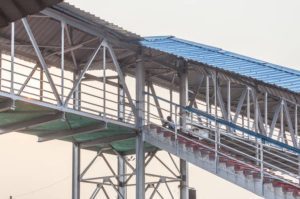Kolkata Area Bridge Rescue: On the morning of June 14, 2025, a heartfelt act of courage unfolded near Kakdwip railway station, on the Sealdah–Namkhana line in South 24 Parganas, West Bengal. Sadhan Das, aged 60, and his six-year-old granddaughter Deepsikha Debnath narrowly escaped tragedy by jumping from a narrow railway bridge into the Kalnagini River to avoid an oncoming train.
Das had taken a shortcut along the tracks leading to the station, carrying Deepsikha when they spotted the train barreling toward them on the same single-track bridge, just around 10 AM. With no room to step aside, the duo opted for a split-second decision—leaping into the water below, approximately 300 feet beneath them.

The Perilous Setting: Why Bridges and Railway Tracks Are Dangerous
Engineering Constraints: Narrow Bridge, Single Track
The Kalnagini bridge accommodates only one rail track, with no pedestrian walkway—common across Bengal’s rural networks. The track is elevated hundreds of feet above the river, amplifying the risk. Such precarious infrastructure frequently forces villagers and commuters alike to use trackside routes, especially when bridges lack proper footpaths.
Shortcut Culture
Walkways beside rail tracks are forbidden but frequently used due to lack of alternative routes. Das was walking an unofficial shortcut—resembling a route many villagers prefer, given limited connectivity between hamlets like Akshaynagar-Shivpur and Kakdwip station.
Split-Second Bravery: The Escape
Upon hearing the train, Das didn’t hesitate. “He kept his head and jumped with his granddaughter,” recalled eyewitness Anal Biswas. Their synchronized leap stunned witnesses; fishermen on the riverbank responded immediately, diving in to rescue the pair, who were unconscious but alive. Both were rushed to Kakdwip Subdivisional Hospital, where they are reported in stable condition.
Kolkata Area Bridge Rescue: Human and Emotional Dimensions
-
Grandfather’s presence of mind: At 60, Das’s decision to act decisively is being lauded as instinctively heroic.
-
Child survival: Deepsikha’s survival underscores the importance of quick but composed decision-making under pressure.
-
Community union: Local fishermen and residents acted collectively, reinforcing Kerala-like spontaneous rescue culture along riverine zones.
Historical Context: Bridge Safety and Accidents in Bengal
Recurring Infrastructure Hazards
Several similar incidents have occurred along trackside bridges in Bengal:
-
Broken tracks, collapsed trees, and narrow railway bridges regularly cause commuter fears.
-
A notorious 1997 derailment near Majerhat bridge reinforced the dangers of ageing rail infrastructure.
Global Similarities
International parallels include instances in rural regions where missing footpaths on railway bridges forced pedestrians into life-threatening scenarios. The Indian scenario reflects a broader issue of neglected rural footpath infrastructure.
Pedestrian Railway Policies: Gap Between Law and Practice
Official Rail Policy
Indian Railways mandates “no pedestrian use” near tracks. Bridges are to include footpaths when possible; however, funds and implementation lag.
Ground Reality
Walking on tracks remains prevalent in semi-urban zones like Kakdwip, due to:
-
Lack of vehicular or foot access
-
Time-saving use of rail routes
-
Local normalization of risky behavior
Grassroots Interventions
Recent awareness drives by NGOs and local Panchayats emphasise:
-
Use of dedicated subways or overpasses
-
Signage on railway approach routes
-
Safety drills through schools and village councils
The Das rescue underscores an urgent need to accelerate these interventions on Sealdah–Namkhana and similar branches.
Expert Insights
Railway safety specialist, Dr. Arindam Mukherjee, states:
“This incident highlights systemic negligence. A 300‑foot drop on a one-track bridge without walkway is an infrastructural crime. We need immediate footpath retrofits.”
Psychologist Dr. Shreya Banerjee adds:
“Victims of such near-misses may develop trauma, especially children like Deepsikha. Counseling and trauma debriefing post-incident is vital.”
Eye-witnessed rescue expert, retired firefighter Mr. Kali Das, weighed in:
“The fishermen’s instinctive response saved lives. It’s essential to train more local volunteers in first-response rescue to help critical survivors.”
Rescue Response: From Water to Hospital
Community Rescue
Fishermen within seconds launched boats and equipment, highlighting how local knowledge of currents can be lifesaving.
Medical Processing
Victims were stabilised for shock, checked for head/spine trauma, hypothermia—both discharged after two days, family statements say.
Broader Impacts: Policy, Infrastructure, and Awareness
Infrastructure Upgrades Advocacy
Local MP Sushmita Bose is urging rail ministries to:
-
Strengthen bridge footpaths
-
Conduct safety audits along river bridges
-
Encourage community involvement in monitoring risks
Safety Campaigns
Railway circulated pamphlets, broadcasted announcements from Kakdwip station, and held meetings in 5 local villages to discourage track use and propose alternate paths.
Media Effect
Television coverage and telegraph reports have spiked national scrutiny, shaking public consciousness and pressuring bureaucrats.
Preventive Measures: What Should Follow?
-
Immediate audit of high-usage bridge segments
-
Construct footpaths or dedicated pedestrian bridges beside rail bridges
-
Deploy warning signs and emergency ladders along high-risk tracks
-
Railway-community partnerships—volunteers, helpline numbers
-
Training local first responders in swift water rescue techniques
Human Interest: The Das Family
Sadhan Das is a daily laborer; Deepsikha, a primary school pupil in the hamlet of Shivpur. Family describes them as humble, resilient. Their survival has inspired local support—villagers have offered to cover expenses, counseling, and visited them in hospital, strengthening neighborhood solidarity.
Kolkata Area Bridge Rescue: A Wake-Up Call Rooted in Heroism
This incident is a potent reminder that infrastructural negligence can have life-threatening consequences. Yet it also shines a light on:
-
Selfless heroism: A grandfather’s instinct and fishermen’s swift action
-
Community resilience: Villagers rallying around survivors
-
Policy imperative: Closing the gap between lifesaving regulations and on-ground reality
If Indian Railways acts decisively—improving rural bridge safety and empowering communities—the next crisis under a bridge over the Kalnagini or elsewhere may be averted entirely.
Railway Safety & Policy
Geographical and Regional Context
Emergency Services and Health
Child and Mental Health Support
Community Safety Awareness
Also read: Home | Channel 6 Network – Latest News, Breaking Updates: Politics, Business, Tech & More

